|
|
|
Sort Order |
|
|
|
Items / Page
|
|
|
|
|
|
|
| Srl | Item |
| 1 |
ID:
147957
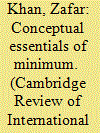

|
|
|
|
|
| Summary/Abstract |
Very little is known about Pakistan's nuclear policy and, in particular, about its adoption of minimum deterrence, given the existence of nuclear ambiguity and the absence of public, official documentation of Pakistan's understanding of minimum deterrence. Therefore, despite its innocuousness, ‘minimum’ remains a vague and complex phenomenon short of definitional concreteness when it is brought to a real conceptual test. On the one hand, minimum is regarded as a small number of deterrent forces arguing against expansion and arms competition, while, on the other hand, it is viewed as a relative, and therefore continually evolving, concept depending on the region's fast-changing strategic environment. A conceptual basis for the concept of minimum is explored, leading to the question: why does Pakistan pursue minimum deterrence? It traces out the rationale of Pakistan's minimum deterrence as conceptualized following the 1998 nuclear tests. This rationale of Pakistan's minimum deterrence is then analysed in light of the essentials of minimum deterrence in order to see whether it is consistent with the basics of minimum as conceived here.
|
|
|
|
|
|
|
|
|
|
|
|
|
|
|
|
| 2 |
ID:
153396
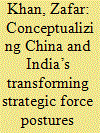

|
|
|
|
|
| Summary/Abstract |
As China and India gradually rise and become the centre point of world politics in the 21st century, both these nuclear states tend to transform their strategic force postures to hide their vulnerabilities and ensure the credibility of their deterrence force. This article conceptualizes the gradual transformation of China and India’s strategic force postures under the essentials of minimum deterrence. In doing so, it examines the conceptualization of minimum deterrence, doctrinal use of deterrent forces and the modernization of strategic forces, though the perceptional aspects of these three imperatives may differ between these two nuclear states. This article attempts to find out whether or not these strategic imperatives, in relation to their transformation of strategic force postures, are consistent with the essentials of minimum deterrence conceived here. This article concludes that if China and India’s deterrence force modernization falls within these essential categories (i.e. modernization, accuracy, upgrades, correcting ranges, credibility, penetrability, survivability), they may be consistent with minimum deterrence. Alternatively, if both China and India go beyond the minimum deterrence that they initially conceptualized, this may remain inconsistent with the minimum deterrence conceptualized here.
|
|
|
|
|
|
|
|
|
|
|
|
|
|
|
|
| 3 |
ID:
175703
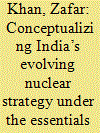

|
|
|
|
|
| Summary/Abstract |
As India intends to complete its ambitious deterrent force projects such as the development of Ballistic Missile Defense (BMD) system, Intercontinental Ballistic Missiles (ICBMs), Multiple Independently Reentry Vehicles (MIRVs), nuclear powered submarines, aircraft carrier, and a number of nuclear reactors as part of its would-be modified Draft Nuclear Doctrine (DND), it is imperative to analyze whether or not India’s shift in its deterrent force posture including that of ambitious deterrent force projects remains consistent with minimum deterrence India earlier conceptualized. This article conceptualizes the rationale of India’s evolving nuclear strategy under the conceptual essentials of minimum deterrence and the limitations to and challenges of India’s ambitious deterrence force posture. Also, the article explores the key factors how and why India might be shifting away from its deterrent force posturing it earlier conceived. However, this article finds that India may not remain consistent with its broader nuclear policy of minimum deterrence conceptualized in its earlier nuclear drafts if it continues to successfully develop these mega deterrent force projects bolstered by sophisticated delivery systems amidst India’s increasing strategic partnership with the US.
|
|
|
|
|
|
|
|
|
|
|
|
|
|
|
|
| 4 |
ID:
106259
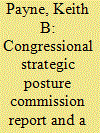

|
|
|
|
|
| Publication |
2011.
|
| Summary/Abstract |
The bipartisan Congressional Strategy Posture Commission offered numerous recommendations to reduce what it labeled "the nuclear danger." The Obama Administration has pursued some of these recommendations via its policy documents, such as the 2010 Nuclear Posture Review, its budgets, and plans. There is reason, however, for several concerns in this regard. These involve the high priority placed on nuclear force reductions at the potential expense of other national goals, including deterrence and assurance; the maintenance of the flexibility and resilience of the U.S. force posture necessary to meet deterrence and assurance requirements now and in the future; continued support for U.S. strategic defensive capabilities given Russian opposition; and apparent interest among some in the Administration to move increasingly toward what has been termed a policy of Minimum Deterrence.
|
|
|
|
|
|
|
|
|
|
|
|
|
|
|
|
| 5 |
ID:
121925
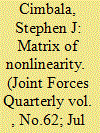

|
|
|
| 6 |
ID:
072010


|
|
|
| 7 |
ID:
083614
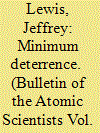

|
|
|
| 8 |
ID:
107579
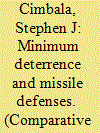

|
|
|
|
|
| Publication |
2011.
|
| Summary/Abstract |
Ratification and entry into force of the New START agreement open the door for possible additional reductions in both states' numbers of deployed long-range nuclear weapons and launchers, but the matrix of post-New START agreement involves nonlinearities with respect to the relationship between minimum deterrence and missile defenses. NATO's Lisbon summit in 2010 invited Russia to participate in a European missile defense system, but Russia is wary of any theaterwide antimissile system that could grow into a more ambitious deterrent-denial force pointed at Russia. Minimum deterrence would drop the numbers of U.S. and Russian strategic nuclear weapons to 1,000 or fewer, but getting Moscow and Washington to move well below 1,000 would require parallel reductions and/or restraints on the part of other nuclear weapons states and a missile defense regime of "cooperative security" rather than mutual suspicion.
|
|
|
|
|
|
|
|
|
|
|
|
|
|
|
|
| 9 |
ID:
111885
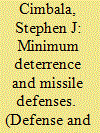

|
|
|
|
|
| Publication |
2012.
|
| Summary/Abstract |
Minimum deterrence is a compromise, or halfway house, between nuclear abolition or nearly zero and assured destruction, the dominant paradigm for strategic nuclear arms control during and after the cold war. Minimum deterrence as applied to the current relationship between the United States and Russia would require downsizing the numbers of operationally deployed long-range nuclear weapons to 1000, or fewer, on each side. More drastic bilateral Russian-American reductions would require the cooperation of other nuclear weapons states in making proportional reductions in their own arsenals. In addition, US plans for European-based and global missile defenses cause considerable angst in Russia and threaten to derail the Obama "reset" in Russian-American relations, despite the uncertainties about current and plausible future performances of missile defense technologies.
|
|
|
|
|
|
|
|
|
|
|
|
|
|
|
|
| 10 |
ID:
140727
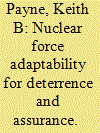

|
|
|
|
|
| Summary/Abstract |
This monograph, Nuclear Force Adaptability for Deterrence and Assurance: A Prudent Alternative to Minimum Deterrence, is the second in a series examining the U.S. goals of deterrence, extended deterrence and the assurance of allies, and how to think about the corresponding U.S. standards of adequacy for measuring “how much is enough?” It begins by examining the manifest character of the contemporary threat environment in which the United States must pursue its strategic goals of deterring foes and assuring allies. Fortunately, there is considerable available evidence regarding the character of the contemporary threat environment and its general directions. Noted historians have compared this threat environment not to the bipolar Cold War, but to the highly dynamic threat environments leading to World War I and World War II. The uncertainties involved are daunting given the great diversity of hostile and potentially hostile states and non-state actors, leaderships, goals, perceptions, and forces that could be involved.
|
|
|
|
|
|
|
|
|
|
|
|
|
|
|
|
| 11 |
ID:
128018
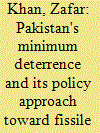

|
|
|
|
|
| Publication |
2014.
|
| Summary/Abstract |
In the immediate aftermath of nuclear weapon tests in May 1998, Pakistan opted
for a policy of minimum deterrence, which entailed that Pakistan would not need
a larger number of nuclear deterrent forces, as a small number of them would be
sufficient to deter. The concept of a minimum deterrence existed even before
Pakistan tested nuclear weapons. However, later Islamabad realized that minimum
could not be sustained as earlier conceptualized. It needed to be evolving and
dynamic. Minimum deterrence (MD) transformed into minimum credible deterrence
(MCD) which had policy implications for Pakistan's force-building structure.
Among its force building, Pakistan not only upgrades its deterrent forces, but also
builds more nuclear reactors which makes Islamabad reluctant to withdraw its
veto from the Fissile Material Cut-off Treaty (FMCT). It requires more fissile
materials in order to enhance its deterrent credibility. Why does Islamabad do
this, and if its policy approach remains consistent with the minimum deterrence it
conceptualized earlier? This article examines the rudimentary factors that increase
Pakistan's security concerns and elaborates on Pakistan's post-1998 shifting policy
approach toward fissile materials in the region's changed strategic environment.
|
|
|
|
|
|
|
|
|
|
|
|
|
|
|
|
| 12 |
ID:
119275
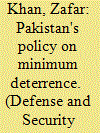

|
|
|
|
|
| Publication |
2013.
|
| Summary/Abstract |
This article focuses on Pakistan's policy option of "minimum deterrence" (MD) post-1998 nuclearization of South Asia and explores why "minimum" in reality is not the minimum. It states that the term "minimum" has not been fully defined yet due to which MD stays ambiguous. In addition, it endeavors to elaborate the rudimentary factors responsible for the non-existence of an MD, which, in turn, keeps the Pakistani stance on MD dynamic and evolving.
|
|
|
|
|
|
|
|
|
|
|
|
|
|
|
|
| 13 |
ID:
128039
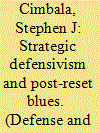

|
|
|
|
|
| Publication |
2014.
|
| Summary/Abstract |
US nuclear deterrence and arms control policy may be moving, by design and by inadvertence, toward a posture of strategic "defensivism". Strategic "defensivism" emphasizes the overlapping and reinforcing impact of: (1) reductions in US, Russian and possibly other strategic nuclear forces, possibly down to the level of "minimum deterrence," (2) deployment of improved strategic and/or theater antimissile defenses for the US, NATO allies and other partners; and (3) additional reliance on conventional military forces for some missions hitherto preferentially assigned to nuclear weapons. This article deals with the first two of these aspects only: the interaction between missile defenses and offensive force reductions in US-Russian strategy and policy. The findings are that stable deterrence as between the USA and Russia is possible at lower than New Strategic Arms Reduction Treaty levels, but reductions below 1000 deployed long-range weapons for each state, toward a true minimum deterrent posture, will require multilateral as opposed to bilateral coordination of arms limitations. Missile defenses might provide some denial capability against light attacks by states with small arsenals, but they still fall short of meaningful damage limitation as between powers capable of massive nuclear strikes.
|
|
|
|
|
|
|
|
|
|
|
|
|
|
|
|
| 14 |
ID:
147398
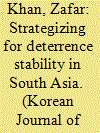

|
|
|
|
|
| Summary/Abstract |
Before the arrival of nuclear weapons in South Asia, both India and Pakistan had fought several wars. The arrival of nuclear weapons has made both the South Asian nuclear weapons states more cautious to fight. This caution and restraint is directly associated with the fear of using nuclear weapons, the damage of which remains unacceptable to both the adversaries. Although nuclear weapons are considered for deterrence purposes and they are assumed to provide deterrence stability, they are not a guaranteed panacea for all the outstanding issues including the core issue of Kashmir. This absence of a guaranteed solution for these problems despite the presence of nuclear weapons entails the deterrence instability in South Asia, even though neither India nor Pakistan are directly fighting anymore because of the fear of major military escalation to a nuclear use. This paper talks about at least three major dynamics associated with nuclear weapons that might help promote deterrence stability in South Asia. It asks for the consistent practice of minimum deterrence that was initially conceptualized, focuses on the practices of defensive doctrinal postures between India and Pakistan, and calls for an arms control regime (ACR) that does not yet exist in South Asia. In addition to other peaceful measures discussed in the existing literature, the amalgamation of these three ingredients and the commonalities within them could play an important role in promoting deterrence stability in South Asia.
|
|
|
|
|
|
|
|
|
|
|
|
|
|
|
|
|
|
|
|
|